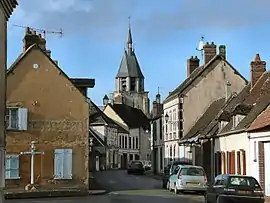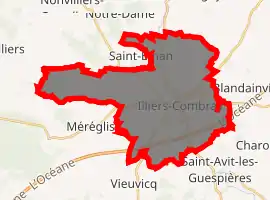Illiers-Combray
Illiers-Combray is a commune in the Eure-et-Loir department in north central France.
Illiers-Combray | |
|---|---|
 The church and surroundings in Illiers-Combray | |
.svg.png.webp) Coat of arms | |
Location of Illiers-Combray 
| |
 Illiers-Combray  Illiers-Combray | |
| Coordinates: 48°18′04″N 1°14′54″E | |
| Country | France |
| Region | Centre-Val de Loire |
| Department | Eure-et-Loir |
| Arrondissement | Chartres |
| Canton | Illiers-Combray |
| Intercommunality | Pays de Combray |
| Government | |
| • Mayor (2008–2014) | Jean-Claude Sédillot |
| Area 1 | 33.60 km2 (12.97 sq mi) |
| Population (2017-01-01)[1] | 3,324 |
| • Density | 99/km2 (260/sq mi) |
| Time zone | UTC+01:00 (CET) |
| • Summer (DST) | UTC+02:00 (CEST) |
| INSEE/Postal code | 28196 /28120 |
| Elevation | 144–204 m (472–669 ft) (avg. 162 m or 531 ft) |
| 1 French Land Register data, which excludes lakes, ponds, glaciers > 1 km2 (0.386 sq mi or 247 acres) and river estuaries. | |
Population
| Year | Pop. | ±% |
|---|---|---|
| 1793 | 3,170 | — |
| 1800 | 2,617 | −17.4% |
| 1806 | 2,829 | +8.1% |
| 1821 | 2,473 | −12.6% |
| 1831 | 2,937 | +18.8% |
| 1836 | 3,069 | +4.5% |
| 1841 | 2,916 | −5.0% |
| 1846 | 3,159 | +8.3% |
| 1851 | 3,136 | −0.7% |
| 1856 | 3,100 | −1.1% |
| 1861 | 3,003 | −3.1% |
| 1866 | 3,005 | +0.1% |
| 1872 | 2,993 | −0.4% |
| 1876 | 2,997 | +0.1% |
| 1881 | 2,795 | −6.7% |
| 1886 | 2,831 | +1.3% |
| 1891 | 2,860 | +1.0% |
| 1896 | 2,795 | −2.3% |
| 1901 | 2,812 | +0.6% |
| 1906 | 3,035 | +7.9% |
| 1911 | 2,985 | −1.6% |
| 1921 | 2,790 | −6.5% |
| 1926 | 2,963 | +6.2% |
| 1931 | 2,734 | −7.7% |
| 1936 | 2,875 | +5.2% |
| 1946 | 3,017 | +4.9% |
| 1954 | 2,937 | −2.7% |
| 1962 | 3,089 | +5.2% |
| 1968 | 2,971 | −3.8% |
| 1975 | 3,407 | +14.7% |
| 1982 | 3,333 | −2.2% |
| 1990 | 3,329 | −0.1% |
| 1999 | 3,225 | −3.1% |
| 2008 | 3,249 | +0.7% |
Literature
Combray was the writer Marcel Proust's name for the village of Illiers (near the Cathedral town of Chartres), vividly depicted by him in the opening chapters of his vast semi-autobiographical novel In Search of Lost Time.
The home of Proust's "Aunt Léonie" in the heart of the village, where he spent much of his childhood, has been transformed into a museum to the writer's memory. It provides visitors with a delightful view of 19th-century provincial life as well as of the many Proustian mementos on display.
It should be added that Proust scholars have recently claimed his descriptions of "Combray" owe as much to the author's stays in his uncle's home in Auteuil, near Paris, as to Illiers-Combray.
As a tribute to Proust's literary masterpiece, the people of Illiers decided, in 1971, to change the town's name to Illiers-Combray, on the occasion of the first centenary of the author's birth.[2]
Twinning
The village is twinned with Coniston, Cumbria, the home of John Ruskin.[3] Ruskin's work was a source of inspiration to Proust.
References
- "Populations légales 2017". INSEE. Retrieved 6 January 2020.
- "Illiers-Combray à la recherche d'un tourisme proustien". La Croix. 2018. Retrieved 19 December 2020.
Voilà 47 ans que la ville, qui s'appelait simplement Illiers, a adopté le nom fictif de «Combray» pour célébrer le centenaire de la naissance de l'auteur.
- Addison, Mike (2014). "Coniston toasts its twin towns". Westmorland Gazette. Retrieved 5 June 2017.
| Wikimedia Commons has media related to Illiers-Combray. |